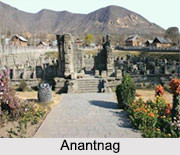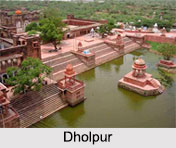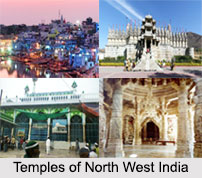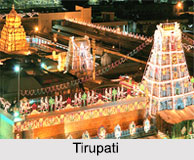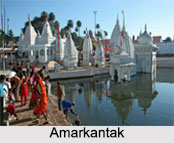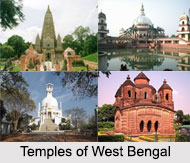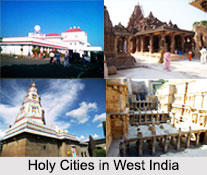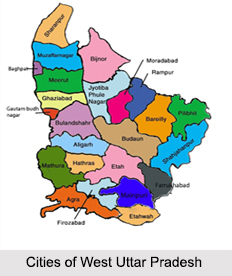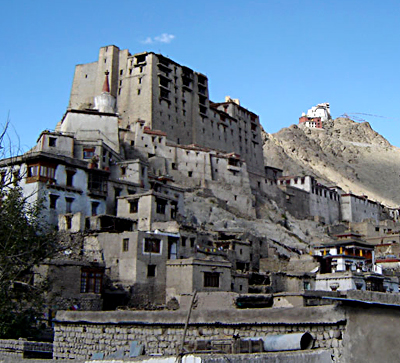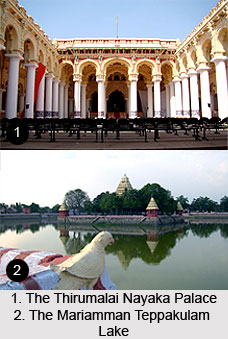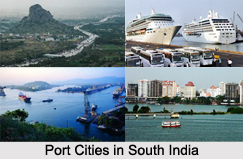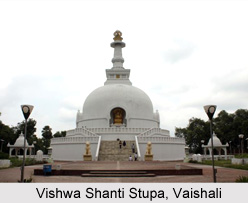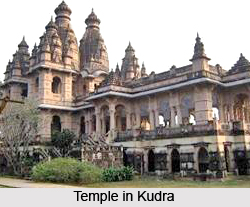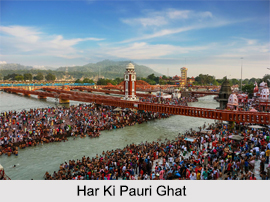Introduction
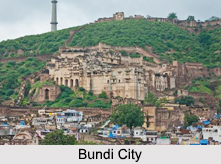 Bundi is a well planned and well maintained city in north western Indian state of Rajasthan. This medieval city of Rajputana era is braided with oriental charm, which is the cynosure to the tourists.
Bundi is a well planned and well maintained city in north western Indian state of Rajasthan. This medieval city of Rajputana era is braided with oriental charm, which is the cynosure to the tourists.
Bundi is beautiful with the ancient havelis and picturesque locations. Bundi has become a leading tourism destination in Rajasthan for its desolate look. The serenity, the vast stretches of Thar desert and the Oriental feel are popularizing tourists. The small winding lanes, markets and the intricate paintings are just fascinating.
Location of Bundi
Bundi is located in Bundi District, which is situated about 35 kilometers from Kota in Kota District of Rajasthan. Bundi is reachable by railways from Jaipur (201 km) and Jodhpur.
History of Bundi
Bundi was founded by Rao Deva Hada, who established it as the capital city of Hadoti kingdom. These Rajputs belonged to the empire of Prithviraj Chauhan in ancient era. They took shelter in Mewar and became the allies of the Rana. Some of them moved on and established separate kingdoms. The founder of Bundi belonged to one of these clans. However Bundi was one of those kingdoms that had good relations with the Mughal Dynasty. The Rajput rulers from Bundi were part of the Mughal kingdom and they had won many battles for the Mughal rulers. Bundi was named after a Meena tribal chieftain Bunda. In early era, Bundi was inhabited by many tribes of Rajasthan. Bundi was previously known as "Bunda-Ka-Nal".
Geography of Bundi
Bundi is positioned at about 25.44 degree north to 75.64 degree east. The average elevation of this city is about 268 meters from the sea level. This city is bounded by Aravalli Mountain Range.
Demography of Bundi
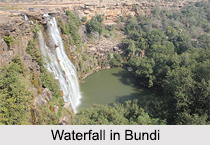 According to the Population Census 2011, Bundi has a population of about 88, 312. The males constitute 53 percent and the females constitute 47 percent. The average literacy rate of Bundi is 67 percent.
According to the Population Census 2011, Bundi has a population of about 88, 312. The males constitute 53 percent and the females constitute 47 percent. The average literacy rate of Bundi is 67 percent.
Culture of Bundi
Bundi shares the cultural elegance with Rajasthan. Bundi Festival is one of the major festivals in this city. Other than Bundi festival, this city in Rajasthan also celebrates Diwali.
Bundi Festival
 Bundi Festival or ` Bundi Utsav` is a colourful festival celebrated in Bundi city in Rajasthan, particularly Hadoti District during the month of `Kartik` according to the Hindi calendar, which constitutes the month of November. This famous festival glorifies the local craftsmanship, traditions and culture which have been existent in Bundi since ancient times, and draws innumerable tourists from all across the globe and national visitors. One will be lucky enough to derive a beautiful taste of the exclusive culture of this western Indian state, if he is present at the Bundi Festival. Various artists from Bundi and also many parts of India conglomerate at Bundi to deliver live performances exhibiting their talents.
Bundi Festival or ` Bundi Utsav` is a colourful festival celebrated in Bundi city in Rajasthan, particularly Hadoti District during the month of `Kartik` according to the Hindi calendar, which constitutes the month of November. This famous festival glorifies the local craftsmanship, traditions and culture which have been existent in Bundi since ancient times, and draws innumerable tourists from all across the globe and national visitors. One will be lucky enough to derive a beautiful taste of the exclusive culture of this western Indian state, if he is present at the Bundi Festival. Various artists from Bundi and also many parts of India conglomerate at Bundi to deliver live performances exhibiting their talents.
A long procession named `Shova Yatra` marks the beginning of the Bundi Utsav, which comprises the active participation of local men and women, all clad in their bright, traditional attires who march along the streets of Hadoti District. This Indian festival is often referred to as the festival of the common masses of the villages, since the rural art and culture is depicted through the events organised in Bundi Festival. Visitors will be tempted to purchase the large variety of traditional handicrafts and pottery artefacts which are displayed and sold at this grand festive event. Numerable spectacular paintings, accomplished by the regional artisans and painters of Bundi are also exhibited as well as sold in the festival. Musical dances, musical vocal performances and camel races are some of the several interesting contests which bring alive the festive ambience at the Bundi Festival.
Keshori Patan town is a tiny town located close to Bundi city, where a small cattle fair is observed during the days of the Bundi Festival, which resembles the grand cattle fair at Pushkar. Vedic hymns are chanted on the banks of Chambal River during this holy occasion and a spiritual ritual known as `Deep Dan` or `Light Donation` ceremony is performed during the Bundi Utsav, while the assembles people are engaged in offering prayers. Turban tying event, bridal dress event, rural sports competitions, etc. are some of the impressive events which add spice to the Bundi Festival. Other events like Musical Band Contests and a programme of classical folk dances are also noticed at this festival.
Tourism in Bundi
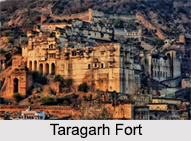 Ornate forts, splendid palaces and Rajput architecture, beautifully carved in brackets and pillars, makes Bundi a place worth visiting. The tourism in Bundi is the prime attraction, located in the south-eastern region in a narrow valley within the Aravalli Hills like an oasis. Bundi is also known as the Blue City of Eastern Rajasthan.
Ornate forts, splendid palaces and Rajput architecture, beautifully carved in brackets and pillars, makes Bundi a place worth visiting. The tourism in Bundi is the prime attraction, located in the south-eastern region in a narrow valley within the Aravalli Hills like an oasis. Bundi is also known as the Blue City of Eastern Rajasthan.
The historical heritage of Bundi and its rich culture is what attracts tourists to the place. Before the 14th century, Bundi was inhabited by a number of different tribes, the most powerful and influential one being the Parihar Meenas. It is from their king, Bunda Meena, is where the name of the region is believed to have come from. Later, the Rajputs took over and ruled this area, leaving behind their indelible marks by way of the architecture of the massive structures scattered across the city. Elaborately discussed below are some of the spots and places of Bundi which are a major tourist attraction and are the reason for the growing tourism in Bundi.
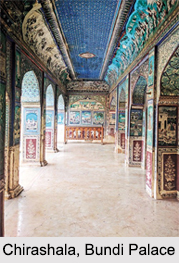 Taragarh Fort: Popularly known as the Star Fort, the Taragarh Fort was built in 1354 AD and is one of the most beautiful attractions of the city. Nestled on a steep hilltop, the fort gives a picturesque view of the city below. There are three gateways to enter the fort- the Lakshmi Pol, Phuta Darwaza and Gagudi ki Phatak. Unlike most other forts and monuments in Rajasthan, the Taragarh Fort has very little Mughal influence in its architecture. The fort represents the fine craftsmanship of the Rajput style, with curved roofs, topping pavilions and kiosks, a profusion of temple columns and ornamental brackets, and typically Rajput motifs such as elephants and lotus flowers. The long winding tunnels of the fort along with the Rani Mahal are also a great attraction in the Taragarh Fort. The Rani Mahal was built exclusively for the royal maidens and mistresses of the king and bore fantastic features which were a reminiscent of the Rajput era.
Taragarh Fort: Popularly known as the Star Fort, the Taragarh Fort was built in 1354 AD and is one of the most beautiful attractions of the city. Nestled on a steep hilltop, the fort gives a picturesque view of the city below. There are three gateways to enter the fort- the Lakshmi Pol, Phuta Darwaza and Gagudi ki Phatak. Unlike most other forts and monuments in Rajasthan, the Taragarh Fort has very little Mughal influence in its architecture. The fort represents the fine craftsmanship of the Rajput style, with curved roofs, topping pavilions and kiosks, a profusion of temple columns and ornamental brackets, and typically Rajput motifs such as elephants and lotus flowers. The long winding tunnels of the fort along with the Rani Mahal are also a great attraction in the Taragarh Fort. The Rani Mahal was built exclusively for the royal maidens and mistresses of the king and bore fantastic features which were a reminiscent of the Rajput era.
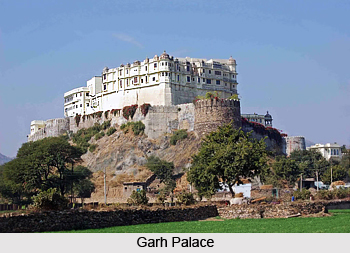 The Garh Palace: Climbing the steep cobbled ramp, the palace is reached through two massive gateways - Hazari Pol and Hathi Pol, where two enormous elephants with raised trunks painted in bright colours top the gateway. The Hathi Pol will lead the tourists to the inner courtyard. Within this inner courtyard lies the Diwan-i-Aam or the hall of public audience. The inner courtyard surrounded by arched arcades and stables has some outstanding murals and there is a white marble throne used for coronation ceremonies. There are several palaces within its premises. The most striking one amongst these is the Chattar Mahal. There is also the Chitra Mahal (Palace of Paintings). The architecture of this monument is truly impressive.
The Garh Palace: Climbing the steep cobbled ramp, the palace is reached through two massive gateways - Hazari Pol and Hathi Pol, where two enormous elephants with raised trunks painted in bright colours top the gateway. The Hathi Pol will lead the tourists to the inner courtyard. Within this inner courtyard lies the Diwan-i-Aam or the hall of public audience. The inner courtyard surrounded by arched arcades and stables has some outstanding murals and there is a white marble throne used for coronation ceremonies. There are several palaces within its premises. The most striking one amongst these is the Chattar Mahal. There is also the Chitra Mahal (Palace of Paintings). The architecture of this monument is truly impressive.
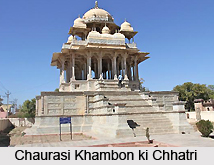 The Deeg Palace: Below the Garh Palace lies the artificial 18th century lake, Nawal Sagar. Apart from its contribution to the pictorial beauty of the surrounding it also reflects the image of the palace and the entire town of Bundi. At its centre stands a temple dedicated to God of Water.
The Deeg Palace: Below the Garh Palace lies the artificial 18th century lake, Nawal Sagar. Apart from its contribution to the pictorial beauty of the surrounding it also reflects the image of the palace and the entire town of Bundi. At its centre stands a temple dedicated to God of Water.
Bundi Palace: Situated on the hillside adjacent to the Taragarh Fort, the massive Palace of Bundi was built by Rao Raja Ratan Singh Hada between 1607 AD and 1631 AD. While entering the palace, there is the imposing Hathi Pol, flanked by two towers and topped by a pair of huge painted elephants. The most spectacular parts of the palace are the Chattar Mahal and the Chitrashala, an arcaded gallery overlooking a hanging garden. The murals in these are regarded as among the finest examples of Rajput painting. The themes they cover include scenes from religious ceremonies, hunting scenes and other princely amusements. The colours are predominantly blue and green, with touches of deep red and yellow.
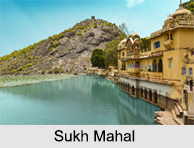 Sukh Mahal: Located on the banks of the Jait Sagar Lake, the Sukh Mahal lies close to the city of Bundi near Kota. The Sukh Mahal is a magnificent summer palace amidst the verdant surroundings of a garden and is known to be another fine example of Rajput architecture. It was the ambience of the Mahal and the palace itself that inspired to write the famous book Kim during his stay there. The palace has now been converted into an irrigation rest house and is one of the popular tourist attractions of the city. On the second floor of the Sukh Mahal, a white marble chhatri or umbrella is placed. There are about 66 cenotaphs present here, which are famous for their cream-coloured marble friezes.
Sukh Mahal: Located on the banks of the Jait Sagar Lake, the Sukh Mahal lies close to the city of Bundi near Kota. The Sukh Mahal is a magnificent summer palace amidst the verdant surroundings of a garden and is known to be another fine example of Rajput architecture. It was the ambience of the Mahal and the palace itself that inspired to write the famous book Kim during his stay there. The palace has now been converted into an irrigation rest house and is one of the popular tourist attractions of the city. On the second floor of the Sukh Mahal, a white marble chhatri or umbrella is placed. There are about 66 cenotaphs present here, which are famous for their cream-coloured marble friezes.
Chaurasi Khambon ki Chhatri: Also known as the 84- pillared cenotaph, the Chaurasi Khambon ki Chhatri is an impressive structure commissioned in the year 1740 by Rao Anirudh Singh, a Rajput ruler of Bundi. The cenotaph has 84 strong pillars and is lavishly decorated with carvings of deer, elephants, dancers and apsaras. It is a two storied structure that stands on a platform and are beautifully designed and festooned with elaborate stylish patterns. On the upper level, there are 16 pillars that support the central cenotaph which is overpowered by a dome along with four chhatris on either side. On the lower level, there is a Shiva Lingam and it is said that the structure was built in honour of Deva, the wet nurse, who took care of the Rajput prince as a kid.
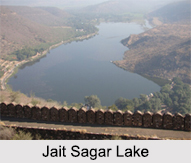 Jait Sagar Lake: Nestled in the Aravalli Mountain Ranges, the Jait Sagar is a beautiful lake that was built by Jait Meena. The beauty of the lake is enhanced by the lotus flowers in full bloom on its surface and is one of the popular tourist spots in the city. Jait Sagar is surrounded by towering walls and has four gateways that serve as entry points to the lake. It is located at a distance of less than 3km from Bundi.
Jait Sagar Lake: Nestled in the Aravalli Mountain Ranges, the Jait Sagar is a beautiful lake that was built by Jait Meena. The beauty of the lake is enhanced by the lotus flowers in full bloom on its surface and is one of the popular tourist spots in the city. Jait Sagar is surrounded by towering walls and has four gateways that serve as entry points to the lake. It is located at a distance of less than 3km from Bundi.
Raniji ki Baori: A noted step-well built in 1699 by Rani Nathavati Ji, who was the younger queen of the erstwhile Rajput ruler Rao Raja Anirudh Singh. Raniji ki Baori is a three storey step-well and has two fantastic well-arched gates with great artwork done on the pillars and statues of elephants made up of white marble. Ogee brackets decorate all the archways and the well is 46 m deep with each of the floors has a place of worship. Baoris were significant social constructions in the medieval Bundi since they acted as assembly areas for the townsfolk.
Other than these the few other tourist attractions of Bundi include the Nawal Sagar and the Phool Sagar Palace, which is a modern palace built in the 20th century, with its well-laid gardens and artificial tanks. Over the years, the tourism in Bundi has increased in popularity due to the medieval charm the city was able to retain for all these centuries. The iconic blue tinge visible in the various architectures all across Bundi is a beautiful sight to behold.
Visiting Information
Bundi is well connected with the other cities of Rajasthan. Cars on hire are available from almost all the cities to arrive. The nearest airport is Jaipur Airport. Bundi Railway Station is about 5 km from the main city.
Accommodation in Bundi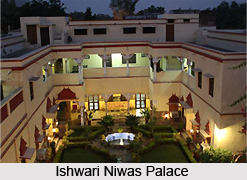 There are several accommodation units in Bundi that offer well-furnished rooms to the visitors. Some of these accommodation units are even 100 years old. These heritage hotels were once upon a time residences of the royal people.
There are several accommodation units in Bundi that offer well-furnished rooms to the visitors. Some of these accommodation units are even 100 years old. These heritage hotels were once upon a time residences of the royal people.
The hotels in Bundi are: -
Ishwari Niwas: This particular palace was built during the reign of Maharaj Raja Ishwari Singh. It was converted in to a hotel by Maharaj Balbhadra Singh in 1992. The services here include attached bath, dining hall, room service, courtyard, sight seeing.
Haveli Braj Bhushanjee: This is a part of heritage stay. The rooms are definitely well provided with all kinds of modern amenities. Room services, sightseeing and dining options are offered to the guests. This is one of the places where the travelers can pamper themselves with Rajasthani hospitality.
Royal Retreat: It is located within the Garh Palace and has 5 rooms` a/c rooms, terrace restaurant, guide, craft shop.
The Umaid Bagh Resorts: It is situated near Lake Jait Sagar. This place offers 15 air-conditioned tents and 2 rooms. This is an interesting place to stay. Attached bath, H/C water, dining, campfire, bird watching, trekking are offered to the guests.
Other hotels in Bundi include RTDC Hotel Vrindawati, Kasera Paradise and Haveli Katkoun. These accommodation units offer world-class service to guests.
